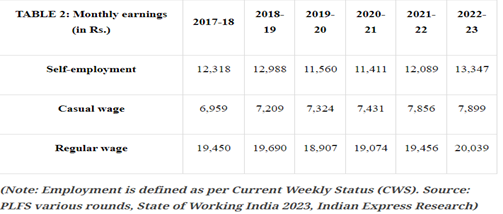

16th October 2023 (9 Topics)
Context:
Recently, the Ministry of Statistics and Programme Implementation has released the results of the Periodic Labour Force Survey (PLFS) for the period July 2022 to June 2023.
About PLFS data:
- PLFS collects data in two ways — Usual Status (US) and Current Weekly Status (CWS).
- Within usual status, the survey respondent has to recall their employment details from the last one year while in the CWS; the respondent has to recall the details over the past one week.
- Usual Status of Employment: The estimate of the labour force in the usual status includes;
- The persons who either worked or were seeking/available for work for a relatively long part of the 365 days preceding the date of survey and also;
- those persons from among the remaining population who had worked at least for 30 days during the reference period of 365 days preceding the date of survey.
- The estimate of the labour force according to the current weekly status approach is derived by considering those who worked for at least 1 hour or was seeking/ available for work for at least 1 hour on any day during the 7 days preceding the date of survey.
Parameters to analyses of PLFS:
- Unemployment Rate (UER): The UER has fallen significantly — from 6.6% to 5.1% over the last year (that is, July to June cycle).
- Simply put, 5.1% of all the people above 15 years of age who demanded work failed to get one.
- Labour Force Participation Rate (LFPR): The UER rate is calculated as a proportion of the population that is demanding work. But this population — which demands work — also goes up and down for a variety of reasons.
- The LFPR is a measure of the total population demanding work, and it is presented as a proportion of the total population that is above 15 years of age.
- India’s LFPR, which had been inching up, shot up significantly in the past year. As of 2022-23, 54.6% of all Indians above the age of 15 were looking for a job.
- LFPR for women: The data shows that female LFPR has gone up over the years but there were two discrete step-ups — one in 2019-20 (when India’s GDP growth rate had slowed down to less than 4% and this was before the Covid pandemic hit) and second in 2022-23 when it rose to 31.6%.
- Worker Population Rate: The WPR is the percentage of persons employed among the persons in the population.
- Thus, instead of looking at how many demand a job and how many fail to get it, the WPR simply gives a measure of how many people have a job as a proportion of the total population.
- WPR among women: This parameters was included specifically to showcase the women participation.
- Monthly earnings: The PLFS reports also provide a sense of how much do people earn in different types of jobs.

- Distribution of workers: The data shows that self-employment has risen and jobs in the other two categories have fallen in proportion.
More Articles

